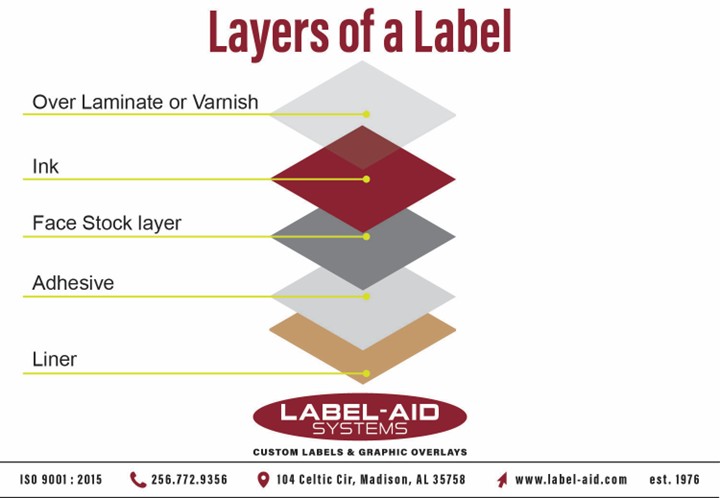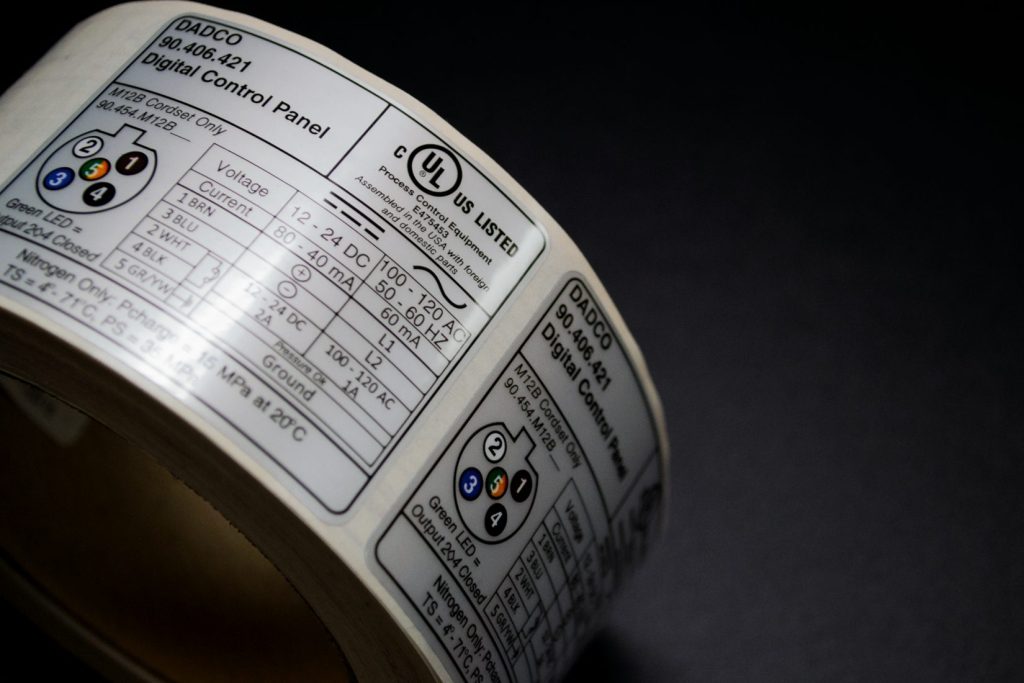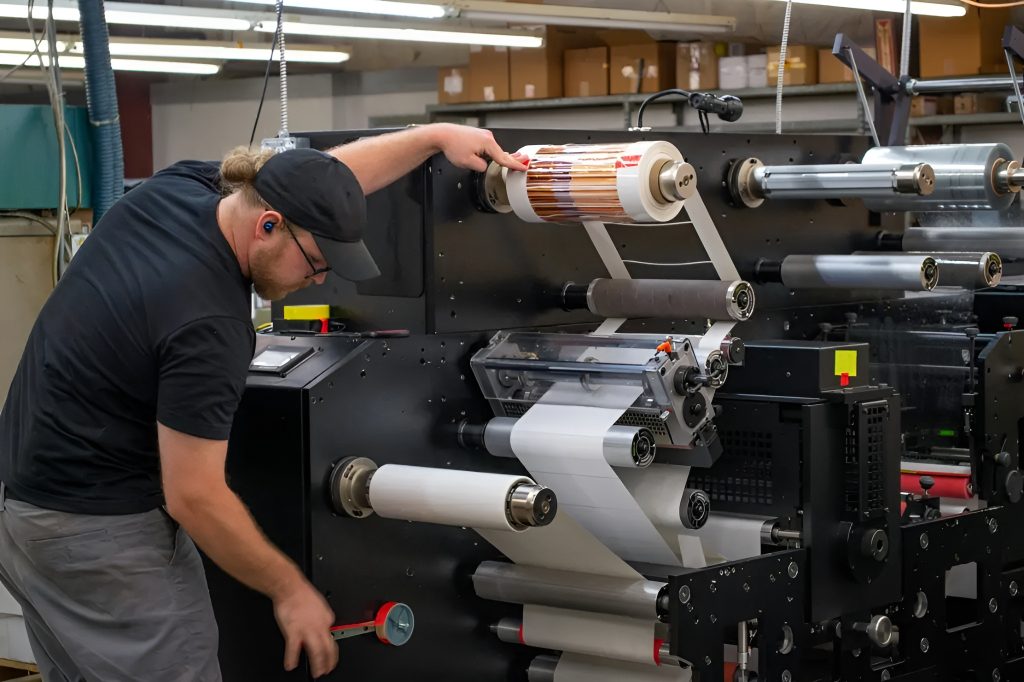

One of the most critical components of the layers that form a custom label is the adhesive.
A single type of label adhesive simply will not work for all applications. Whether you are labeling outdoor equipment, medical devices, retail products, books, high temperature items, or automotive parts the performance of your label depends heavily on choosing the right pressure sensitive adhesive (PSA). With 50 years in business, Label-Aid Systems has the experience and expertise to take the guesswork out of your next labeling project. Let us be your expert label consultants!
When you adhere your custom label to your product, the adhesive under the face stock, allows the label to stick to it, when pressure is applied. Pressure sensitive adhesives are specialized adhesives that form a bond when light to moderate pressure is applied to a surface. Unlike heat-seal, solvent-activated, or water-activated adhesives, PSAs require no external activation—no heat, no water, no chemical mixing.
This unique property makes PSAs incredibly versatile, enabling fast, clean, and simple application across a wide range of surfaces and environments. You’ll find them on everything from printed circuit boards and automotive components, to consumer products and industrial equipment.
Tack or Initial Tack
Initial tack describes how sticky the label adhesive is immediately upon contact with the surface being labeled (how well it “grabs”). High initial tack means it has an immediate strong bond, or grab. Low tack means the initial bond is not as great (but it will improve over time).
Ultimate Adhesion or Bond Strength
The ultimate strength of the bond between the label/adhesive and the surface is called ultimate adhesion. This is reached with most of our products in 24 hours, or sooner. Ultimate adhesion is influenced by a range of factors focused on the surface which is labeled, such as surface energy, surface roughness, surface temperature, and environmental factors.
Application Temperature Range
The range of temperatures for applying your custom labels to your product or surface, for a particular specified adhesive.
Shear or Shear Strength
Shear refers to how well the label adhesive holds once bonded to a surface, while an attempt is made to slide the label off the surface. High shear strength means the label can’t be shifted, slid, pulled, or pushed on the surface labeled easily.
Peel Strength
Peel strength refers to how easily or how hard it is for the label to be pulled away from the surface that has been labeled. A high peel strength indicates that it is more difficult, to break the adhesive bond.
Acrylic based adhesives are made through a process of polymerization, where monomers are linked together, and additives like tackifiers (improved tack) and cross-links (improved strength and durability) are added to formulate acrylic adhesives. Other additives control peel strength, shear resistance, and temperature ranges. This mixture is applied to the silicone label liner, and then the face sheet is added.
Advantages – Acrylic Based Adhesives
Disadvantages – Acrylic Based Adhesives
Examples of Uses:

Rubber based adhesives are made from natural or synthetic polymers, and additives. Some of the additives used are tackifiers (enhanced stickiness), plasticizers (enhanced flexibility), antioxidants (enhanced stability), fillers (enhanced viscosity), and crosslinkers (enhanced cohesive strength).
Advantages-Rubber Based Adhesives
Disadvantages – Rubber Based Adhesives
Examples of Uses:
Permanent Adhesives
Most of the labels we manufacture have a permanent adhesive. That means that the ultimate adhesion is strong, making it difficult to remove without damaging the label or the surface that is being labeled.
Permanent Adhesives with Added Coat Weight
For applications on rough, coarse, or uneven surfaces, an added coat weight of the adhesive is sometimes needed. The adhesive is thicker, which helps it to fill in the peaks and valleys of the irregular surface, to make a stronger bond. Added coat weight products are more expensive, and we can help you determine if they are genuinely needed.
Repositionable Permanent Adhesives
In some cases, our customers desire to remove the label after it has been initially adhered to their product and to reposition the label without any residue (from adhesive or substrate). There are label adhesives that give you a period in which you can lift the label from your product and reposition it without any damage to the label or surface being labeled, and no residue. The label will reach ultimate adhesion and be a permanent label after 24 hours or less. This repositioning should be done soon after the initial labeling occurs. We can test this for you and give you all the parameters you need to know about a label adhesive’s repositionability. How repositionable an adhesive is will depend significantly on the surface being labeled.
Removable Adhesives
Removable adhesives for labels are designed to adhere securely to a surface, then cleanly remove later, without damaging the label or the surface being labeled. Please note: With time, a removable label’s bond strength increases, making it more difficult to remove the label cleanly. The surface being labeled greatly determines how long the removable adhesive will remove cleanly. We can help you test!
Ultra-Removable Adhesives
We suggest ultra-removable adhesives if you desire long term removability. While they do not stick as aggressively as removable labels, they remain removable for a much longer time.
Cold Temp Adhesives
These label adhesives are specially made to bond to surfaces in freezing temperatures and maintain their bond. These label adhesives are flexible and sticky in temperatures down to -40°F. Even in these low temperatures, the cold temp label adhesives remain high tack and moisture resistant—excellent adhesive for food products.
Tamper Evident Adhesives
When peeled, this label will display the message “VOID.” The adhesive separates from the backing to reveal a positive VOID on the item’s surface, while this message appears in reverse on the label itself. Once the custom void sticker has been peeled away, it may not be re-applied or re-sealed, indicating it has been tampered with. Tamper evident void labels have a polyester face sheet and can be overlaminated for extra protection for indoor or outdoor use. Permanent acrylic adhesive sticks well to most surfaces including those that are low surface energy (LSE). Tamper evident void labels come in white and silver substrates, with a corresponding VOID pattern in white and silver. Any custom size or colors are available.

Pressure sensitive adhesives might be hidden beneath the surface, but they play a starring role in how your label performs. From visual appeal to regulatory compliance, and from environmental resistance to user experience, the adhesive is the key component of label functionality.
At Label-Aid Systems Inc., we take pride in providing engineered solutions that combine appearance, performance, and reliability. With five decades of experience in custom labels, decals, and nameplates, we understand what it takes to make a label that sticks.
Need Help Choosing the Right Label Adhesive?
Let us take the guesswork out of your next labeling project. Contact our team of adhesive experts for a free consultation. We’ll help you design a label that performs perfectly in your environment, every time.
📞 Call us today or 📧 contact us online to get started.
About Label-Aid Systems Inc.
Label-Aid Systems Inc. is a U.S.-based manufacturer of custom labels, nameplates, and decals. With a focus on innovation, quality, and customer service, we serve a wide range of industries including medical, automotive, industrial, and consumer goods. Our commitment to engineered label solutions ensures every product performs in the real world.
